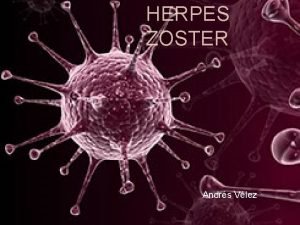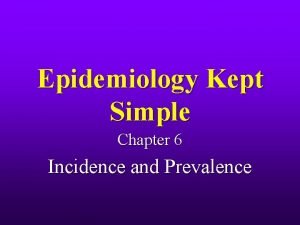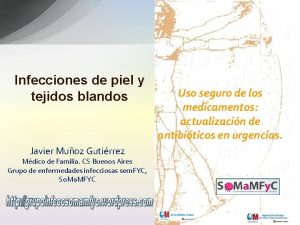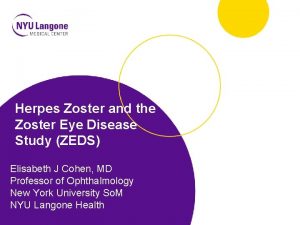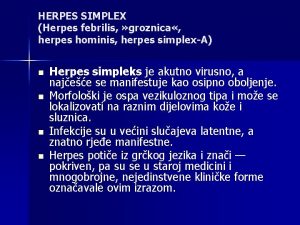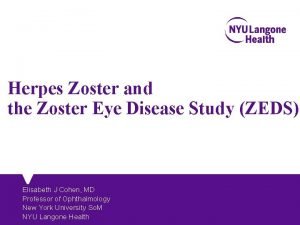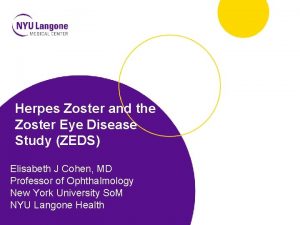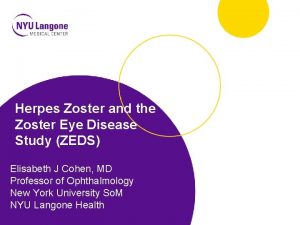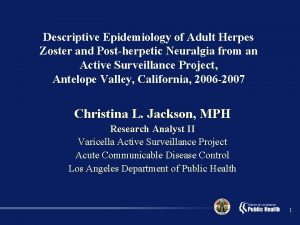Incidence and risk factors for herpes zoster in









- Slides: 9

Incidence and risk factors for herpes zoster in rheumatoid arthritis patients receiving upadacitinib Kevin Winthrop, MD, MPH Oregon Health & Science University Portland, OR, USA APPROVED ACR EDUCATION PARTNER. This activity is included in the ACR's Education Partner program. Independent reporting and the viewpoints expressed are those of Infomedica and its affiliates and do not represent the ACR. SUPPORTED BY AN UNRESTRICTED EDUCATIONAL SPONSORSHIP FROM

Key message • RA patients receiving JAK inhibitors have been reported to have increased risk for herpes zoster. • Analysis of data from five randomized Phase 3 trials showed HZ events are more common with upadacitinib compared to adalimumab or methotrexate, and at the higher 30 mg dose. • Risk factors identified were prior history of HZ, older age, and Asian region. Highlights from ACR Convergence 2020 – Developed by Infomedica

Background (1) What do we already know about this topic? • Upadacitinib is an oral JAK inhibitor with selectivity for JAK 1. • The background rate of herpes zoster (HZ) in people with RA is around 0. 98/100 person years (PY), compared to 0. 37/100 PY in the general population. 1, 2 • A class effect has been reported for HZ with JAK inhibitors. Highlights from ACR Convergence 2020 – Developed by Infomedica

Background (2) How was this study conducted? • This study evaluated the incidence and risk factors for HZ in patients with RA receiving upadacitinib in the phase 3 clinical trial program. • Data were collated from five randomized trials: SELECT-EARLY, SELECT-MONOTHERAPY, SELECTNEXT, SELECT-COMPARE, and SELECT-BEYOND – representing 2629 patients over 4565 PY. • Risk factors were assessed using univariate and multivariate Cox regression models. Highlights from ACR Convergence 2020 – Developed by Infomedica

Findings (1) What does this study add? • Over the Phase 3 program, HZ occurred in 142 patients (3. 1/100 PY) with upadacitinib 15 mg, 126 (5. 5/100 PY) with 30 mg, 8 (1. 0/100 PY) with adalimumab plus methotrexate, and 5 patients (1. 1/100 PY) with methotrexate monotherapy. • Most cases (about 71%) with upadacitinib and all cases with other active treatment involved a single dermatome, with little invasive or non-cutaneous involvement. • Ophthalmic involvement was seen in 4. 2% and 2. 4% of cases in the 15 and 30 mg groups, respectively, and unilateral involvement with multiple dermatomes was seen in 18. 3% of cases at each dose. • Over time, the risk of HZ infection with 30 mg was about double than that seen with 15 mg. Highlights from ACR Convergence 2020 – Developed by Infomedica

Findings (2) What does this study add? • HZ history was shown to be a strong risk factor, while use of corticosteroid was not • There was a single case of HZ meningitis reported in a Japanese patient on upadacitinib 30 mg. • In addition, patients aged 65 or older had an increased risk of HZ in the 15 mg group. • This study showed that fewer than 5% of patients across the treatment groups reported prior vaccination against HZ. Highlights from ACR Convergence 2020 – Developed by Infomedica

Perspectives How does this study impact clinical practice? • HZ events in RA patients treated with upadacitinib were more common with upadacitinib compared with adalimumab or methotrexate, and with the 30 mg dose versus 15 mg. • Prior history of HZ, older age, and Asian region were associated with an increased risk of HZ in both upadacitinib groups. • Screening for risk factors in clinical practice can help to identify and manage patients. • Vaccination against herpes zoster should be considered prior to treatment with JAK inhibitors. Highlights from ACR Convergence 2020 – Developed by Infomedica

References 1. Smitten AL, Choi HK, Hochberg MC, et al. The risk of herpes zoster in patients with rheumatoid arthritis in the United States and the United Kingdom. Arthritis Rheum 2007; 57: 1431– 8. 2. Yun H, Yang S, Chen L, et al. Risk of Herpes Zoster in Autoimmune and Inflammatory Diseases: Implications for Vaccination. Arthritis Rheum 2016; 68: 2328– 37. Highlights from ACR Convergence 2020 – Developed by Infomedica

Related content • Siegel SAR, Winthrop KL. In the Real World: Infections Associated with Biologic and Small Molecule Therapies in Psoriatic Arthritis and Psoriasis. Curr Rheumatol Rep 2019; 21(7): 36. • Cohen SB, Tanaka Y, Mariette X, et al. Long-term safety of tofacitinib up to 9. 5 years: a comprehensive integrated analysis of the rheumatoid arthritis clinical development programme. RMD Open 2020; 6(3): e 001395. • Winthrop KL, Harigai M, Genovese MC, et al. Infections in baricitinib clinical trials for patients with active rheumatoid arthritis. Ann Rheum Dis 2020; 79(10): 1290– 7. • Winthrop K, Nash P, Yamaoka K, et al. Incidence and Risk Factors for Herpes Zoster in Rheumatoid Arthritis Patients Receiving Upadacitinib. Presented at ACR Convergence 2020; abstract 2002. Highlights from ACR Convergence 2020 – Developed by Infomedica
